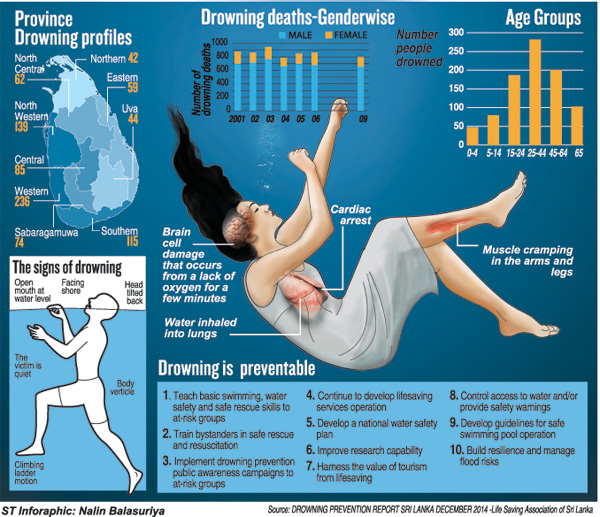News
Lanka has one of the highest rates of death by drowning
Sri Lanka has one of the highest rates of drowning in the world with more than three deaths a day, due mainly to carelessness and ignorance of basic safety rules, the Life Saving Association says.
The Drowning Prevention Report compiled by the Association last year, the first of its kind done in the country, detailed the alarming extent of the problem. Last year, 1100 people died from drowning, the Life Saving Association of Sri Lanka’s (LSASL) chief examiner and trainer, Asanka Nanayakkara, said.
“Sri Lanka has one of the highest incidents of drowning in a comparison of 61 countries, and 10th highest when compared to 35 low and middle-income countries,” the report, compiled with the support of the World Health Organisation (WHO) along with the Life Saving Victoria, an Australian organisation, revealed.
Mr. Nanayakkara indicated the actual toll might be higher, saying drowning deaths were always not recorded as death caused by water but sometimes attributed to death caused due to heart attack, epilepsy, choking, brain damage or respiratory issues or an accident caused by excessive alcohol consumption.
Most cases of drowning came from recreational activity, with holiday-makers at the sea, tanks or rivers who completely ignored basic safety measures. “If a group gets into the water the well-trained swimmers must always be at the deep end and also be vigilant about the depth of the water and also if there are muddy areas and with plants in which it is easy to get entangled,” Mr. Nanayakkara said.
“In many instances, when one person in a group is seen losing control in the water, another person who is usually unskilled in lifesaving activity will jump in, and this often results in more tragedy.“If someone gets into the water to help a drowning victim he or she is taking a risk. It takes a great deal of skill to get a drowning person to safety.”
Mr. Nanayakkara, who is also a Certified Instructor by the International Life Savers Federation explained that assistance can be provided to a drowning person by throwing out a rope, a tyre or similar object but not getting into the water unless the rescuer is trained to do so.
A crowd of people could join hands and go into the water to pull the victim or throw out a long rope with a knot while shouting out instructions to the victim to grab, hold and pull himself or herself ashore. Mr. Nanayakkara said people should avoid swimming to show off to others and must realise their own limitations.
“Over-confidence is a dangerous thing and often leads to drowning,” he added. He cautioned against swimming after heavy meals or when hungry, or when injured, in poor health or in extreme weather conditions so as to avoid cramps.“People get into the water wearing clothing unsuitable for swimming and also wade into the water after exertion,” Mr. Nanayakkara said.
The Sri Lankan Navy said it received many reports of drowning cases each year. Spokesman Commander Indika Silva said the Navy had saved four people from drowning in tanks in Anuradhapura and Polonnaruwa during the recent Poson festival.
“Most people do not see the danger in water and go to bathe in tanks and rivers without thinking that it can take a life within minutes. Usually by the time we are alerted and we arrive at the scene, it is too late,” Commander Silva said.
“Water currents are unpredictable so there must be great caution when wading into water,” he said.The key reasons for drownings, the Navy spokesman said, were due to swimming in unknown water bodies, ignoring danger signs and getting trapped in pits dug in rivers and tanks during droughts.
He advised people travelling in boats to wear lifejackets. The Navy provides lifesaving facilities in areas such as the Nilaweli beach in Trincomalee as well as the Beira Lake in Colombo.


